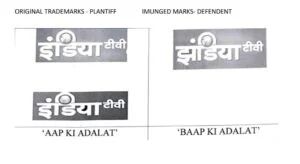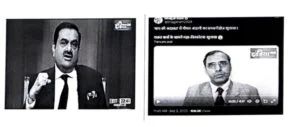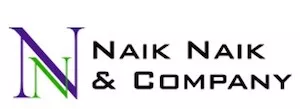In a significant ruling, Justice Anish Dayal of the Delhi High Court granted an ex-parte ad-interim injunction in favour of Independent News Service Private Limited (India TV) in a trademark infringement case filed against one Ravindra Kumar Choudhary and others, in an order dated May 30, 2024.
The case revolves around a well-known and prominent television program "Aap Ki Adalat" and the unauthorised use of marks/logos by the Defendant No.1 that are deceptively like those of Independent News Service Private Limited. The primary grievance was against Defendant No. 1, Ravindra Kumar Choudhary, a self-proclaimed political satirist, who allegedly used a deceptively similar mark on his social media handles.
The Plaintiffs, Independent News Service Pvt. Ltd and its Chairman and Editor-in-Chief, Mr. Rajat Sharma, filed a suit seeking a permanent injunction to restrain the Defendants from using marks and logos similar to Aap Ki Adalat and India TV. Independent News Service Pvt. Ltd. which incorporated in 1997, operates the popular Hindi news channel "India TV" and has a long-standing show Aap Ki Adalat which has garnered immense popularity and recognition.
The Plaintiff argued that this usage infringed upon their registered trademark and violated their intellectual property rights not only phonetically and visually but also conceptually conveyed similar idea.
Court's Analysis & Findings
The Court examined the material placed on record by the Plaintiff and prima facie came to the conclusion the image impugned mark is deceptively similar to the registered mark of the Plaintiff and therefore, this is the fit case for grant of ex-parte ad-interim injunction. The key points of the court's analysis included the following:
- Phonetic Similarity: The court found that "Aap Ki Adalat" and "Baap ki Adalat" are phonetically similar. The use of "Baap" instead of "Aap" does not sufficiently distinguish the two, especially taking into consideration the identical structure and cadence of the phrases.
- Visual Similarity: The visual presentation of "Baap ki Adalat" was also found to be similar to "Aap ki Adalat". The Plaintiffs demonstrated how the defendant's logo and presentation style mimicked their very own, which could lead to confusion amongst the audience. The following pictures can give a better understanding of the above similarities:
- Conceptual Similarity: Conceptually, both phrases imply a courtroom setting, reinforcing the likelihood of confusion. The court noted that the defendant's usage leveraged the established reputation and format of "Aap Ki Adalat" to attract views.


It is highly evident by looking at the above pictures how the style and format of the show is copied by the defendant.
- Previous Precedents: The Plaintiffs referred to its previous cases where the court had upheld trademark rights, such as:
- Independent News Service Pvt. Ltd. vs. India Broadcast Live LLC & Ors
- Independent News Service Pvt. Ltd. vs. Sanjeev Shrivastva & Ors.
- The court's decision underscores the importance of protecting intellectual property rights covering various dimensions of trademark infringement, including phonetic and visual similarities, especially in the realm of media and broadcasting.
Granting The Interim Injunction
Based on the above findings, the court concluded that the Plaintiffs had established a prima facie case for infringement. Accordingly, the Court restrained use of Infringing Marks and directed Defendant No.1 i.e. Ravindra Kumar Choudhary and his affiliates to refrain from using "Baap Ki Adalat" or any similar mark/logo in any form, including social media posts, audio-video content, and domain names. The Defendant No.1 has also been directed to remove infringing content from his social media platforms. While passing the ex-parte injunction order, Court also felt important to protect Personality Rights of Mr. Rajat Sharma by restraining the Defendants from using his photograph, video, or name in any infringing manner.
Implications Of The Order
Even though this is an ex-parte ad-interim order, it reinforces the stringent protection afforded to trademarks and the importance of distinctiveness in branding. It highlights various critical legal principles such as:
- Phonetic and Visual Similarity: The court's emphasis on phonetic and visual similarity underscores the need for businesses to create distinct and unique marks to avoid legal conflicts. Even slight variations that do not alter the overall impression can lead to a finding of infringement.
- Conceptual Analysis: The order passed also demonstrates that conceptual similarities are equally significant. Marks that evoke the same idea or concept, even if the phonetically or visually distinct, can still infringe upon established trademarks.
- Precedential Value: By referring the previous judgments, the court showcases the value of precedent in intellectual property cases.
- Personality rights: The protection of personality rights is crucial, particularly for public figures whose names and likenesses hold a significant value. This aspect of the order safeguards individuals from unauthorised commercial exploitation of their identity.
Conclusion
The Delhi High Court's interim injunction in favour of Independent News Service Pvt. Ltd. in underscores the robust enforcement of trademark protections and highlights the judiciary's critical role in safeguarding intellectual property rights. The directive to remove infringing content from social media platforms ensures that the injunction has practical implications, effectively curbing ongoing harm and demonstrating the court's commitment to comprehensive enforcement. This aspect underscores the necessity of effective mechanisms to translate legal remedies into tangible outcomes. Collectively, these elements of the ruling set a significant precedent for future trademark disputes, particularly in media and broadcasting, and serve as a cautionary tale for entities attempting to leverage the reputation and goodwill of establishes brands. It also highlights the critical importance of distinctiveness in branding and the comprehensive protection of intellectual property to ensure that trademark owners can confidently invest in their brands without fear of unauthorised appropriation.
This detailed order encapsulates the multifaceted approach of the court in adjudicating trademark disputes, encompassing phonetic, visual, and conceptual similarities, thereby ensuring the legal rights of trademark owners are upheld and respected. As businesses navigate the complex landscape of intellectual property, this decision provides a clear reminder of the legal principles that underpin trademark protection and judiciary's crucial role in enforcing these rights, making it vital for all stakeholders. This case also involves the misuse of personality rights and how important it is to protect these rights. Personality rights are something which protect an individual's persona from unauthorized commercial exploitation and have evolved significantly over time. In India, these rights have been affirmed through various landmark judgments. For instance, in the case of Anil Kapoor v. The Indian Express Limited, the court recognized the unauthorized use of Kapoor's image in an advertisement, underscoring the need for consent. Similarly, Amitabh Bachchan's case against the use of his voice in a phone call service highlighted the protection of vocal identity. Jackie Shroff's case further cemented these rights, where unauthorized use of his persona in a comic book was deemed a violation of his personality rights. These cases collectively illustrate the judiciary's evolving approach in upholding the commercial and personal interests of public figures against unauthorized exploitation.
Click Here To Read The Judgment
The content of this article is intended to provide a general guide to the subject matter. Specialist advice should be sought about your specific circumstances.


